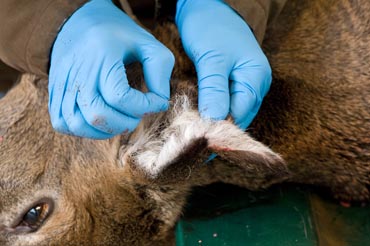As ticks expand, new areas may become prone to Lyme disease
Last summer, after returning home from a walk in Madison’s Dudgeon-Monroe neighborhood, Susan Paskewitz was astonished to find a deer tick crawling up her dog’s hind leg. It was the first time Paskewitz, a UW–Madison entomologist, had collected a tick in the city. Within the month, she learned of two other such cases.

Professor of entomology Walter Goodman collects deer tick samples at a Department of Natural Resources deer station near Black Earth, Wis., on Nov. 22, 2008, as part of a study documenting the prevalence of Lyme disease throughout the state.
Photo: Bryce Richter
“It was striking to get three (deer ticks) last year in the Madison metro area,” says Paskewitz, who specializes in mosquitoes and ticks. “We usually only get one every few years.”
Deer ticks — the type known for carrying Lyme disease — are widely associated with Wisconsin’s Northwoods. In truth, however, they occupy a much larger territory. In 1994, a deer tick “census” led by Paskewitz revealed they had already become established in the western two-thirds of the state. Since then, reports of Lyme disease and new infestations led Paskewitz to suspect that they had become prevalent throughout Wisconsin.
To find out, Paskewitz conducted another census last fall, and the results confirmed her suspicions. “Pretty much everywhere in Wisconsin is infested now,” she explains. “The only place we’re not getting them is down (in the very southeast corner of the state) near Bong Recreational Area.”
This information, however worrisome, is critical for the control and treatment of Lyme disease. For instance, the state’s public-awareness campaign, which instructs citizens how to avoid deer-tick bites and monitor themselves for signs of disease, will soon be broadcast more broadly to better reflect the parasite’s true range. In addition, the Wisconsin Division of Health, through local public-health officials, will share this information with the state’s doctors, who can often cure Lyme disease outright if it’s caught during the first month after a bite. “But if the physician isn’t aware that there are deer ticks in their area,” says Paskewitz, “they may not look into that diagnosis very carefully.”
Another troubling reality is that deer ticks are taking up residence around the state’s most heavily populated areas, including Appleton, Madison, Milwaukee and Oshkosh. Paskewitz predicts we will see an increase in bites among city dwellers who frequent natural areas outside the city limits, as well as suburban homeowners with properties abutting wooded areas. Nonetheless, she doesn’t recommend curtailing outdoor activities. Instead, people should be aware and proactive: checking themselves for ticks and seeking treatment if they develop a bull’s-eye shaped rash or experience flu-like symptoms during the summer.
“In Wisconsin, people sort of feel like they already know this story. They know there’s Lyme disease here, but one thing this (survey) points out is that it’s not a static situation,” says Paskewitz. “What your risk was 20 years ago may not be what your risk is today. It may have significantly increased, so you should not be blasé if you get a tick on you.”




